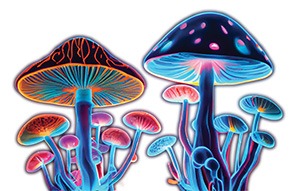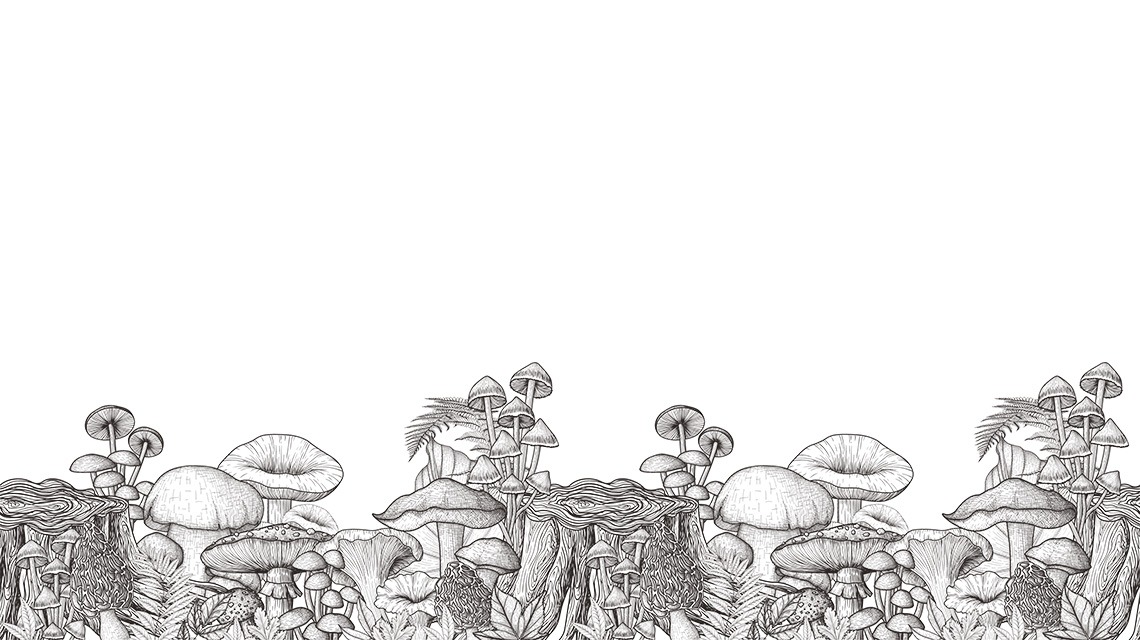Can fungi save us?
There is a school of thought that says we’ll be able to fix the mess humankind has created in the natural world by employing human ingenuity: MacGyvering our salvation. But there may be a better chance we can find solutions to many of these problems by harnessing the almost godlike powers of a species far older than ourselves.
Mushrooms.
They are the oldest organism found on dry land. Fungus-like forms date back 2.4 billion years and were found in rocks once beneath the oceans. Mushrooms are the fruiting of fungi, analogous to their apples if you think of the more than 1.5 million species of mycelium, the rootlike structure of fungi, as the tree. This is six times more species than plants.
In the coming years, your trade show booth could be built of materials made entirely of mycelium products–including the tables and the chairs covered in mycelium leather. When their useful life is over, they will be composted.
“Your trade show booth could be built of materials made entirely of mushroom products.”
Mushroom products are already being tested and employed to tackle more pressing concerns. Like us, mycelia are heterotrophic, which means they have to eat their food, unlike plants which get their energy from sunlight.
Healthy Eating
 The mycelium that produces oyster mushrooms, which are sold in supermarkets, has, in lab experiments, consumed the herbicide glyphosate–commonly known as Roundup, the most widely used weed killer in the world that has been shown to be dangerous to the health of bees, soil and aquatic health, and biodiversity in general as well to human health.
The mycelium that produces oyster mushrooms, which are sold in supermarkets, has, in lab experiments, consumed the herbicide glyphosate–commonly known as Roundup, the most widely used weed killer in the world that has been shown to be dangerous to the health of bees, soil and aquatic health, and biodiversity in general as well to human health.
Read More: Healthy You: Biohacks for Planners
In his fascinating book, “Entangled Lives,” the British biologist Merlin Sheldrake delves into many strains of what is called mycoremediation, the restoring of contaminated ecosystems through use of fungi. A nonprofit named CoRenewal, for instance, is researching the ability of fungi to detoxify the poisonous byproducts of 26 years of oil drilling in the Ecuadorian Amazon by Chevron. In California, miles of tubes packed with oyster mushroom mycelium have been laid out “in the hopes they will remediate the toxic runoff from houses destroyed in 2017 wildfires.”
In the Netherlands, in 2018, floating booms filled with this same mycelium were placed in a harbor “to replace plastic foam in buoyant rings used to float tsunami-detection devices with a mycelial alternative.” Researchers in Pakistan have found a fungal strain that eats up polyurethane plastic.
A key player in what is becoming a crusade to harness mushroom power is Paul Stamets. His TED Talk–”Six Ways that Mushrooms Can Save the World”–has had millions of views. As Sheldrake recounts it, “As a teenager, Stamets suffered from a debilitating stammer. One day, he took a heroic dose of magic mushrooms and climbed to the top of a tall tree, where he was trapped by a lightning storm. When he came down, his stammer was gone. Stamets was converted.”
In addition to books on mushroom identification and cultivation, Stamets runs hugely successful Fungi Perfecti, in Olympia, Washington, which describes itself as “a family-owned, environmentally friendly company specializing in using mushrooms to improve the health of the planet and its people.” It sells mycelium-based supplements.
Among Stamets’ current passions is saving the bees. Beekeepers have been losing nearly a third of their hives annually due to what appears to be a combination of pesticides, parasites and increased viral levels. In 2015, Stamets and university researchers began experimenting with feeding bees mycelium extracts. Peer-reviewed results indicate this “confers an immune benefit…that translates into improved hive health,” according to Fungi Perfecti’s website.
Stamets and his partners are now planning to market a BeeMushroomed Feeder to “make this nutritive food easily available to bees to sustain their natural health in this time of crisis.”
Growing Furniture
If you’ve purchased certain Dell computer products lately, the packaging was mycelium based. IKEA is said to be looking at ways to replace plastic packaging with similar substitutes. A major innovator in this is Ecovative Design, based in upstate New York. Using waste like corn stalks as a growing medium, the company trains mycelium to become materials to replace brick, concrete, particle board, acoustic tiles, boards and molded packaging for wine bottles. Not to mention animal leather, hundreds of square feet of which can be grown in less than a week.
In a tour for Sheldrake, CEO Eben Bayer gestured to a stool. Its seat was covered with mycelium leather and padded with mycelium foam. “Safe, healthy, sustainably grown furniture,” he said.
This article appears in the November 2023 issue. You can subscribe to the magazine here.





